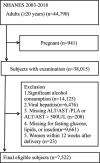Role of age, gender and ethnicity in the association between visceral adiposity index and non-alcoholic fatty liver disease among US adults (NHANES 2003-2018): cross-sectional study
- PMID: 35314476
- PMCID: PMC8938699
- DOI: 10.1136/bmjopen-2021-058517
Role of age, gender and ethnicity in the association between visceral adiposity index and non-alcoholic fatty liver disease among US adults (NHANES 2003-2018): cross-sectional study
Abstract
Objectives: The association between visceral adiposity index (VAI) and the prevalence of non-alcoholic fatty liver disease (NAFLD) has not been fully determined. Here, we aimed to explore the association between VAI and NAFLD in the general US population, and further investigate whether the association involves population differences.
Design: Cross-sectional population-based study.
Setting: The National Health and Nutrition Examination Survey (2003-2018).
Participants: A total of 7522 participants aged 20 years or older who have complete information for NAFLD assessment test were included in this study.
Primary and secondary outcome measures: NAFLD was assessed by the modified fatty liver index for the US population (USFLI) using a cut-off point of 30. Correlation between VAI and NAFLD prediction scores was calculated using the partial correlation analysis. Logistic regression models were further used to estimate ORs and 95% CIs.
Results: Insulin resistance (IR), inflammation and waist circumference-adjusted partial correlation analysis indicated that VAI scores were positively correlated with USFLI (r=0.404 for men, and r=0.395 for women; p<0.001). In a comparison of the highest versus the lowest quartiles of VAI, multivariable logistic regression analysis demonstrated a positive association between VAI and NAFLD (OR (95% CI)=1.97 (1.12 to 3.47) for men, OR (95% CI)=4.03 (1.98 to 8.20) for women). The stratified analyses revealed that the positive association involves age/gender-specific and ethnic differences. As for the impact of metabolic disorders, our results revealed that the association was independent of IR and diabetes, but it would be confounded by other metabolic disorders. However, no significant association was found between VAI and hepatic fibrosis.
Conclusion: VAI is positively associated with the prevalence of NAFLD, but not hepatic fibrosis among US adults, and the association involves age/gender-specific and ethnic differences. The results reported here have important public health implications in NAFLD screening in the future.
Keywords: epidemiology; hepatology; public health.
© Author(s) (or their employer(s)) 2022. Re-use permitted under CC BY-NC. No commercial re-use. See rights and permissions. Published by BMJ.
Conflict of interest statement
Competing interests: None declared.
Figures


Similar articles
-
Association between visceral adiposity index, lipid accumulation product and type 2 diabetes mellitus in US adults with hypertension: a cross-sectional analysis of NHANES from 2005 to 2018.BMC Endocr Disord. 2024 Oct 15;24(1):216. doi: 10.1186/s12902-024-01750-x. BMC Endocr Disord. 2024. PMID: 39407231 Free PMC article.
-
Mediating effect analysis of visceral adiposity index on free triiodothyronine to free thyroxine ratio and non-alcoholic fatty liver disease in euthyroid population.Front Endocrinol (Lausanne). 2022 Aug 29;13:961803. doi: 10.3389/fendo.2022.961803. eCollection 2022. Front Endocrinol (Lausanne). 2022. PMID: 36105392 Free PMC article.
-
Visceral adiposity index, hypertriglyceridemic waist and risk of diabetes: the China Health and Nutrition Survey 2009.Int J Obes (Lond). 2014 Jun;38(6):840-7. doi: 10.1038/ijo.2013.181. Epub 2013 Sep 19. Int J Obes (Lond). 2014. PMID: 24048141
-
Visceral adiposity and inflammatory bowel disease.Int J Colorectal Dis. 2021 Nov;36(11):2305-2319. doi: 10.1007/s00384-021-03968-w. Epub 2021 Jun 9. Int J Colorectal Dis. 2021. PMID: 34104989 Review.
-
The Visceral Adiposity Index in Non-Alcoholic Fatty Liver Disease and Liver Fibrosis-Systematic Review and Meta-Analysis.Biomedicines. 2021 Dec 13;9(12):1890. doi: 10.3390/biomedicines9121890. Biomedicines. 2021. PMID: 34944706 Free PMC article. Review.
Cited by
-
The Visceral Adiposity Index and Its Usefulness in the Prediction of Cardiometabolic Disorders.Nutrients. 2025 Jul 20;17(14):2374. doi: 10.3390/nu17142374. Nutrients. 2025. PMID: 40732999 Free PMC article. Review.
-
Race and Ethnicity in Non-Alcoholic Fatty Liver Disease (NAFLD): A Narrative Review.Nutrients. 2022 Oct 28;14(21):4556. doi: 10.3390/nu14214556. Nutrients. 2022. PMID: 36364818 Free PMC article. Review.
-
MASLD: Prevalence, Mechanisms, and Sex-Based Therapies in Postmenopausal Women.Biomedicines. 2025 Apr 2;13(4):855. doi: 10.3390/biomedicines13040855. Biomedicines. 2025. PMID: 40299427 Free PMC article. Review.
-
Relationship Between Six Insulin Resistance Surrogates and Nonalcoholic Fatty Liver Disease Among Older Adults: A Cross-Sectional Study.Diabetes Metab Syndr Obes. 2023 Jun 7;16:1685-1696. doi: 10.2147/DMSO.S409983. eCollection 2023. Diabetes Metab Syndr Obes. 2023. PMID: 37309507 Free PMC article.
-
The relationship between anthropometric indices and non-alcoholic fatty liver disease in adults: a cross-sectional study.Front Nutr. 2025 Jan 7;11:1494497. doi: 10.3389/fnut.2024.1494497. eCollection 2024. Front Nutr. 2025. PMID: 39839301 Free PMC article.
References
-
- Loomba R, Sanyal AJ. The global NAFLD epidemic: NAT Rev Gastroenterol Hepatol 2013;10:686–90. - PubMed
Publication types
MeSH terms
LinkOut - more resources
Full Text Sources
Medical
Research Materials
